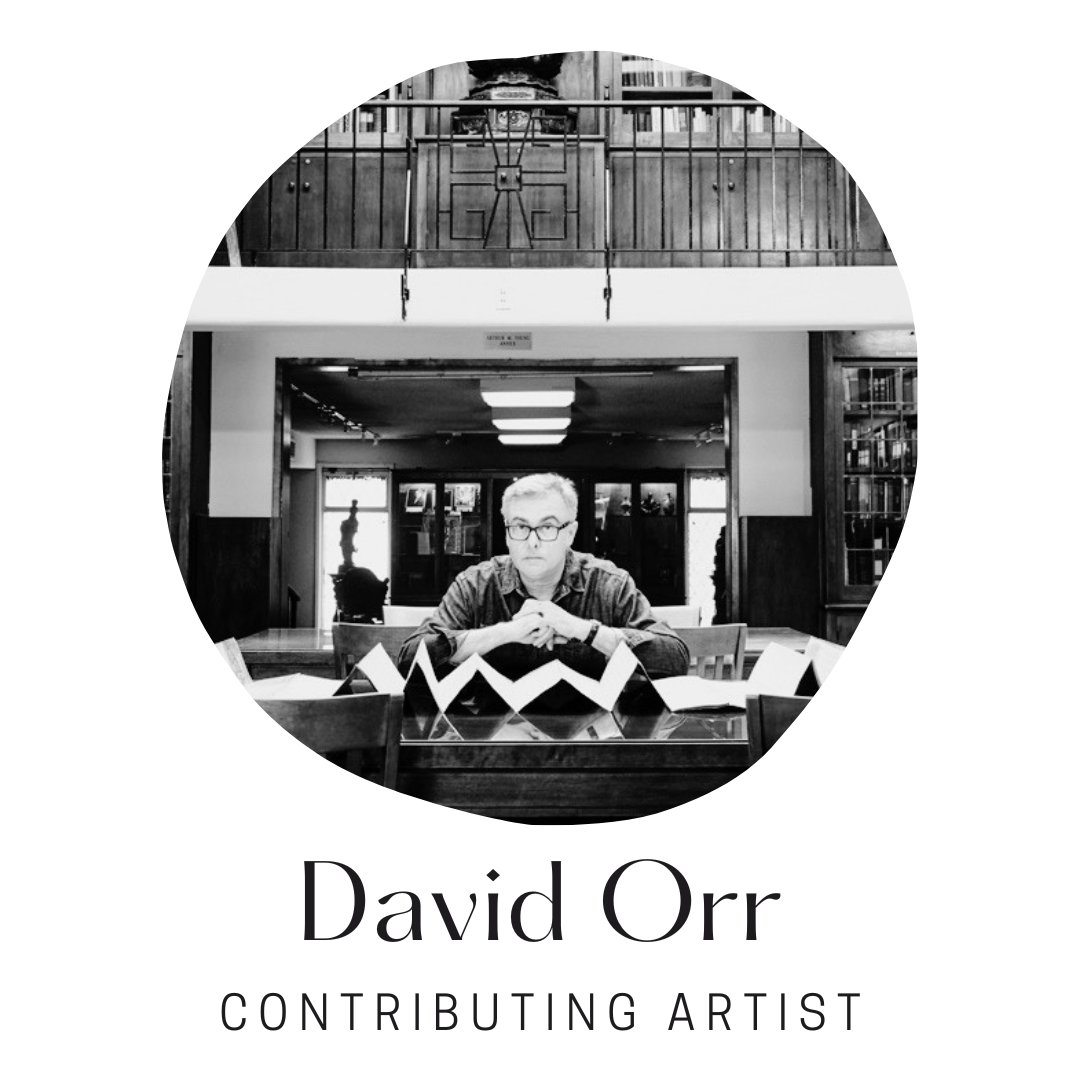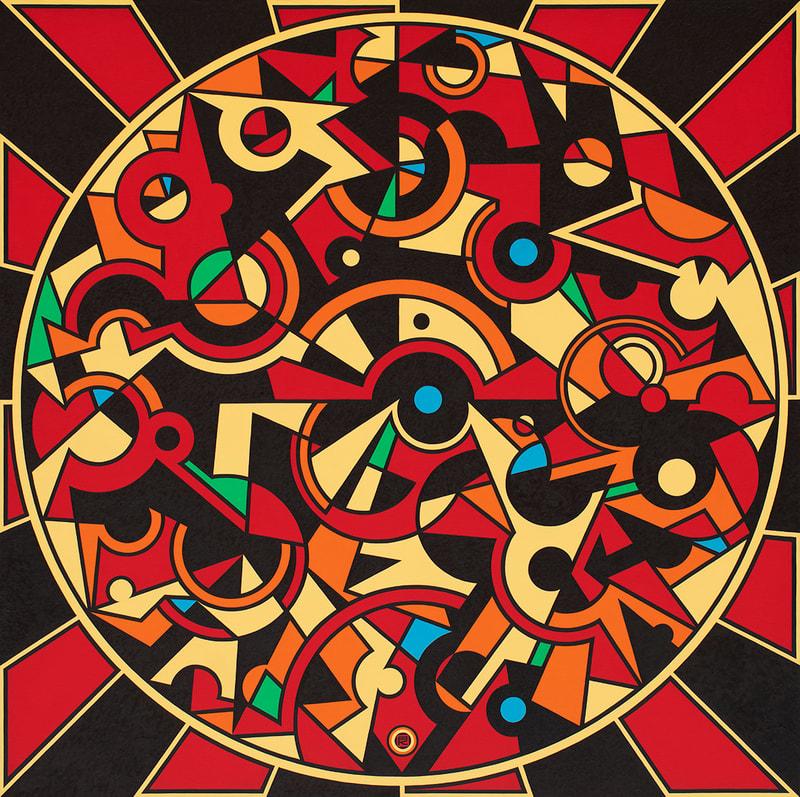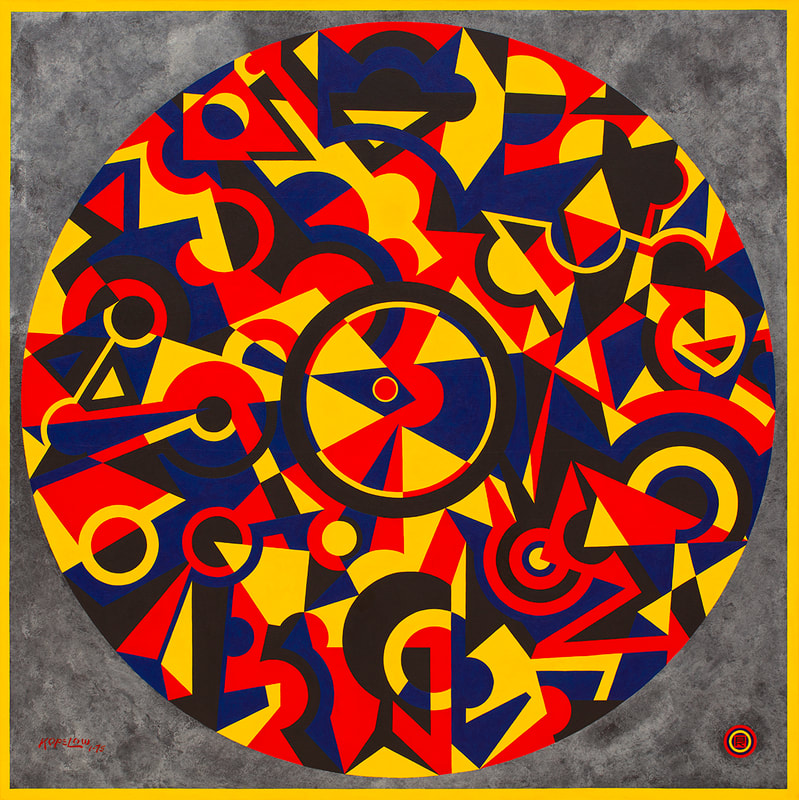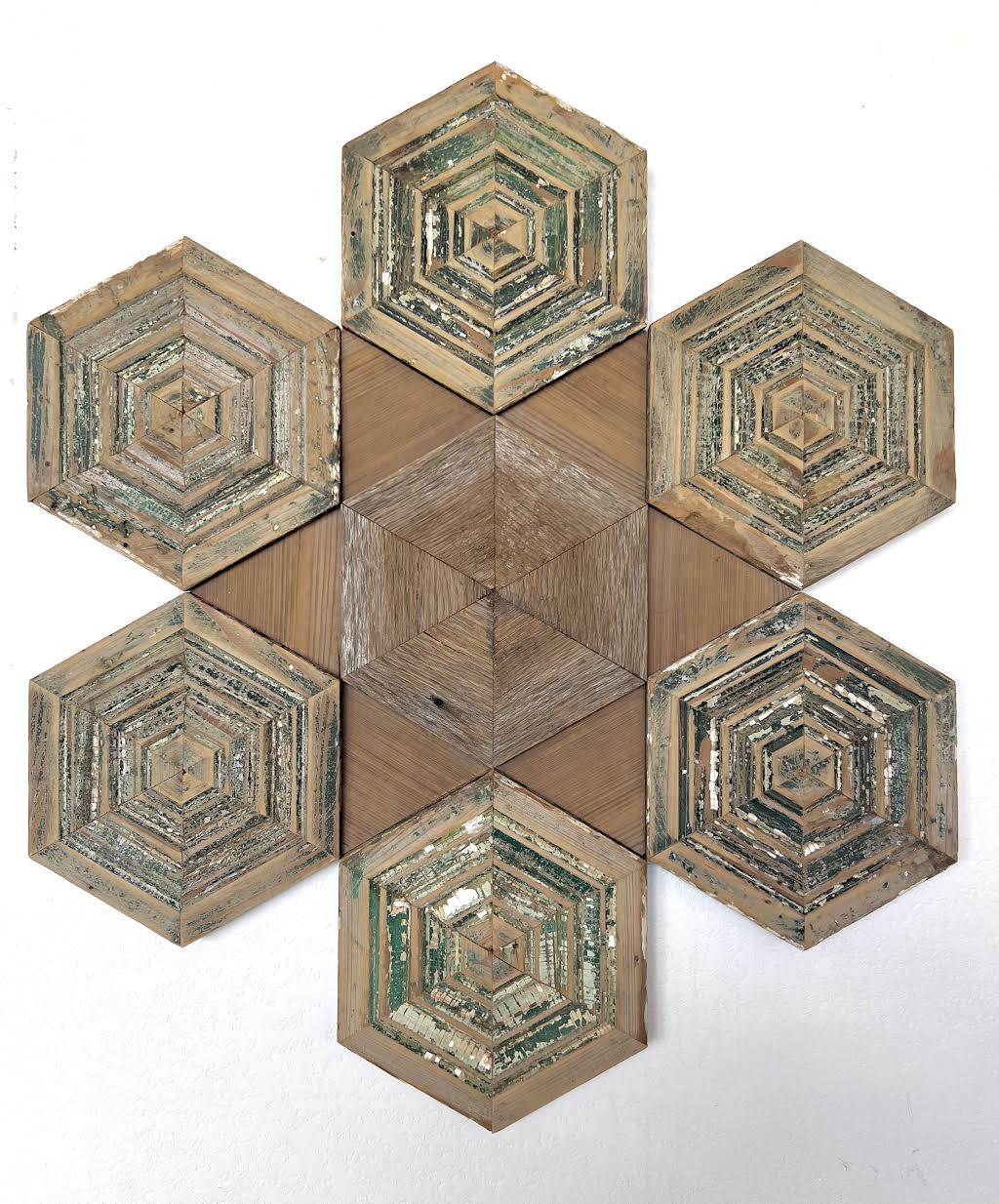Contributing Artists
|
David Orr is a visual artist based in California. His work has been shown extensively in the United States and internationally in shows juried by representatives from the de Young Museum, theInternational Center for Photography, the Lucie Awards, the Metropolitan Museum of Art, The New Museum of Contemporary Art, The New York Times, and the Whitney Museum of American Art, among others. His work is in public collections among such artists as Ansel Adams, John Baldessari, Jim Dine, David Hockney, The Brothers Quay, Edward Weston, and Joel-Peter Witkin.
His work has appeared in Art Daily, Buzzfeed, Communication Arts, Graphis, Harper’s, Hyperallergic, The Photo Review, Print, The Art Director’s Club, The Society of Publication Designers, Psychological Perspectives, The Theosophist, Tricycle: The Buddhist Review, VICE, and VICTOR: The Hasselblad Magazine. Independent film projects have aired on Channel 4 Britain and PBS. He speaks about his work regularly, and has presented at The Joseph Campbell Foundation, Death Salon, The Director’s Guild of America, Dublintellectual, The Mütter Museum, The New School, Parsons School of Design, The Philosophical Research Society (where he established the contemporary arts program, served as curator, and founded the Hansell Gallery), Reed College, Tibet House US, and UCLA, among other venues. He is a member of The Long Now Foundation. Born in Manhattan and raised on the East Coast, David lives and works in Los Angeles david-orr.com // @davidorrart |
Exhibitions
INAUGURAL EXHIBIT: ILLUMINED
The artist donated The Private Instructions of Helena Petrovna Blavatsky which is on display in the PRS Bookstore.
Exhibition by Los Angeles-based artist and photographer David Orr, whose images are made from and inspired by our library's storied collection of rare texts and manuscripts.
For the ILLUMINED series David photographed spiritual, mystical, and philosophical texts—often one-of-a-kind, hand-printed and illuminated manuscripts—from our library’s private collection. After photographing a text, he recombines it, creating an abstracted, circular form that alludes to the worldview or mythology being represented. Each image becomes a balanced form, similar to a mandala, an idealized object of contemplation. The images are dye-infused into highly reflective aluminum discs, creating works of art that are as much objects as photographs.
“Worlds visible and invisible to us have been depicted in strikingly similar visuals over time,” says David, “the recurring form is always circular. Most often, these depictions possess a radial symmetry with repeated shapes emerging from a central point. You can see this arrangement in church and mosque ceilings meaning to represent the impossible order of the heavens; representations of the universe throughout time (the word cosmos itself means ‘order’); and in graphic depictions of particle motion, music, and sound—even the graphic symbol for chaos has order!”
Orr chose each text with an eye towards representing a range of disparate beliefs, from the sacred to the secular. The series includes recombinations of rare Alchemical and Theosophical manuscripts, hand-transcribed Buddhist Sūtras, and a first edition of Francis Bacon’s scientific work. “So many ideas and systems describe how the world works, and much of it can be thought of as a projection of our ideas onto the world,” Orr adds. “There are remarkable examples of ancient ideas proven correct by contemporary scientific study; Quantum Physics and Eastern thought, for example. These images mean to honor the ways in which we struggle to make sense of the world. Each image serves as a symbol and beacon of an ideal—sparks of thought in the dark.”
Exhibition by Los Angeles-based artist and photographer David Orr, whose images are made from and inspired by our library's storied collection of rare texts and manuscripts.
For the ILLUMINED series David photographed spiritual, mystical, and philosophical texts—often one-of-a-kind, hand-printed and illuminated manuscripts—from our library’s private collection. After photographing a text, he recombines it, creating an abstracted, circular form that alludes to the worldview or mythology being represented. Each image becomes a balanced form, similar to a mandala, an idealized object of contemplation. The images are dye-infused into highly reflective aluminum discs, creating works of art that are as much objects as photographs.
“Worlds visible and invisible to us have been depicted in strikingly similar visuals over time,” says David, “the recurring form is always circular. Most often, these depictions possess a radial symmetry with repeated shapes emerging from a central point. You can see this arrangement in church and mosque ceilings meaning to represent the impossible order of the heavens; representations of the universe throughout time (the word cosmos itself means ‘order’); and in graphic depictions of particle motion, music, and sound—even the graphic symbol for chaos has order!”
Orr chose each text with an eye towards representing a range of disparate beliefs, from the sacred to the secular. The series includes recombinations of rare Alchemical and Theosophical manuscripts, hand-transcribed Buddhist Sūtras, and a first edition of Francis Bacon’s scientific work. “So many ideas and systems describe how the world works, and much of it can be thought of as a projection of our ideas onto the world,” Orr adds. “There are remarkable examples of ancient ideas proven correct by contemporary scientific study; Quantum Physics and Eastern thought, for example. These images mean to honor the ways in which we struggle to make sense of the world. Each image serves as a symbol and beacon of an ideal—sparks of thought in the dark.”
THE UNIFIED FIELD: Picking Up the Signal
THE UNIFIED FIELD: Picking Up the Signal features the work of emerging and established artists, working in a wide array of disciplines: photography, painting, performance, sculpture, spoken word, multimedia, installation, and interactive. In each case the work addresses the world beyond reason, and the ways in which we access it. The artists are: Michael Carter, Linda Connor, Mandy Kahn, Jeff Kober, Burton Kopelow, Joey Lehman Morris, Kristin Palombo, Craig Semetko, John Slepian, and Carel Struycken.
The exhibit is curated by LA-based artist, curator, and director David Orr.
The exhibit is curated by LA-based artist, curator, and director David Orr.
'Squaring the Circle' a solo art exhibition by Burton Kopelow
curated by David Orr
An exhibition of paintings by visionary California colorist, Burton Kopelow, as well as a book launch for a new full-color publication about his life and work. Kopelow's catalogue ranges from abstract, mystical mandalas reflecting his interest in Jung, alchemy, consciousness, and personal transformation, to figurative works with mythological and Dionysian themes. On view will be two large-scale (81” x 81”) mandala paintings—vibrant representatives of Kopelow’s seminal abstract series, Chromorphism. Chromorphism codified the artist’s philosophical vision centered on Theosophy, Tibetan thangka paintings, and the thought of C. G. Jung, especially his psychology of mandalas, which Jung considered expressions of the total Self. Squaring the Circle is remarkable for being the third ever exhibition of Kopelow’s work and the very first time these select paintings have been shown. PRS is a fitting place for such a display, as Kopelow explored the subjects of his passionate interests in the PRS library and corresponded with PRS founder, Manly Hall, regarding the Society’s collection of mandalas.
Squaring the Circle’s opening reception included presentations by curator David Orr and Nancy Blumstein, author of the stunning retrospective book, Burton Kopelow: Paths of Discovery, which celebrates its debut on this occasion (copies will be available for purchase during the event, as well as through PRS’ on-site and online bookstore). A roundtable discussion with Kopelow’s contemporaries and Sandra del Castillo, PhD., ritual artist and doctorate in Depth Psychology with a specialization in Jungian and Archetypal Studies from Pacifica Graduate Institute, will follow and the Hansell Gallery will be open for preview and reception hours, allowing visitors ample time to absorb, as Orr writes, the “vivid kinetic geometry” of Kopelow’s “asymmetrical yet balanced” mandalas.
“What at first may seem to be irrational, is a dimension of consciousness-expanded awareness resulting in visions that turn on colors and forms. These paintings incorporate changes so intimate that they achieve consistency. I call this experience Chromorphism.” – Burton Kopelow
Burton Kopelow (1924-2015) was a Brooklyn-born, self-taught artist and early resident of the Downtown LA Loft scene in the 1980s. He discovered his artistic calling and dedication to color when, as a teen, a shade of ultramarine blue sang to him from a Titian painting while wandering New York’s Metropolitan Museum of Art. Kopelow received a Purple Heart after being wounded in World War II and thereafter studied literature and philosophy at NYU under the GI Bill. His interest in philosophy expanded upon moving to Los Angeles and frequenting institutions like the Philosophical Research Society, where he encountered metaphysics and Theosophy’s influence on early 20th century art.
Kopelow’s work, which numbers over 3,000 pieces, draws from multiple chapters of his colorful, bohemian life in the US and Mexico and tells the story of an artist who explored and invented radically different styles over his lifetime. His catalogue ranges from abstract, mystical mandalas reflecting his interest in Jung, alchemy, consciousness, and personal transformation, to figurative works with mythological and Dionysian themes.
While living in Sacramento and San Francisco in the 1970s, Kopelow created his philosophical opus in paint with a series and practice he called Chromorphism. As Blumstein writes, Chromorphism exemplified Kopelow’s “use of painting as a personal meditative tool. The 24 large-scale canvases of Chromorphism are intended as a transformative journey and were designed to be shown together” to produce, in Kopelow’s words, a “visual symphony.”
Kopelow worked in relative obscurity until 2014, just one year before his passing, when his first solo show at LA Artcore’s Brewery Annex launched to much fanfare and record attendance. Even despite limited mobility in later years, he continued painting daily, driven by a never-ending pursuit to glean deeper knowledge through artistic practice. Kopelow was greatly admired by his peers as an “artist’s artist,” who had an intense work ethic, ignored artworld trends, and painted for the sheer joy of it. // burtonkopelow.com
images: Burton Kopelow, Chromorphism I – Dissolution – Green, No. 2 Yellow [Ritual Dance of the Four Directions], 1975; Burton Kopelow, Chromorphism I – Dissolution – Green, No. 5 Red [Solar Flare Tropical], 1979; photos of exhibition by David Orr
Squaring the Circle’s opening reception included presentations by curator David Orr and Nancy Blumstein, author of the stunning retrospective book, Burton Kopelow: Paths of Discovery, which celebrates its debut on this occasion (copies will be available for purchase during the event, as well as through PRS’ on-site and online bookstore). A roundtable discussion with Kopelow’s contemporaries and Sandra del Castillo, PhD., ritual artist and doctorate in Depth Psychology with a specialization in Jungian and Archetypal Studies from Pacifica Graduate Institute, will follow and the Hansell Gallery will be open for preview and reception hours, allowing visitors ample time to absorb, as Orr writes, the “vivid kinetic geometry” of Kopelow’s “asymmetrical yet balanced” mandalas.
“What at first may seem to be irrational, is a dimension of consciousness-expanded awareness resulting in visions that turn on colors and forms. These paintings incorporate changes so intimate that they achieve consistency. I call this experience Chromorphism.” – Burton Kopelow
Burton Kopelow (1924-2015) was a Brooklyn-born, self-taught artist and early resident of the Downtown LA Loft scene in the 1980s. He discovered his artistic calling and dedication to color when, as a teen, a shade of ultramarine blue sang to him from a Titian painting while wandering New York’s Metropolitan Museum of Art. Kopelow received a Purple Heart after being wounded in World War II and thereafter studied literature and philosophy at NYU under the GI Bill. His interest in philosophy expanded upon moving to Los Angeles and frequenting institutions like the Philosophical Research Society, where he encountered metaphysics and Theosophy’s influence on early 20th century art.
Kopelow’s work, which numbers over 3,000 pieces, draws from multiple chapters of his colorful, bohemian life in the US and Mexico and tells the story of an artist who explored and invented radically different styles over his lifetime. His catalogue ranges from abstract, mystical mandalas reflecting his interest in Jung, alchemy, consciousness, and personal transformation, to figurative works with mythological and Dionysian themes.
While living in Sacramento and San Francisco in the 1970s, Kopelow created his philosophical opus in paint with a series and practice he called Chromorphism. As Blumstein writes, Chromorphism exemplified Kopelow’s “use of painting as a personal meditative tool. The 24 large-scale canvases of Chromorphism are intended as a transformative journey and were designed to be shown together” to produce, in Kopelow’s words, a “visual symphony.”
Kopelow worked in relative obscurity until 2014, just one year before his passing, when his first solo show at LA Artcore’s Brewery Annex launched to much fanfare and record attendance. Even despite limited mobility in later years, he continued painting daily, driven by a never-ending pursuit to glean deeper knowledge through artistic practice. Kopelow was greatly admired by his peers as an “artist’s artist,” who had an intense work ethic, ignored artworld trends, and painted for the sheer joy of it. // burtonkopelow.com
images: Burton Kopelow, Chromorphism I – Dissolution – Green, No. 2 Yellow [Ritual Dance of the Four Directions], 1975; Burton Kopelow, Chromorphism I – Dissolution – Green, No. 5 Red [Solar Flare Tropical], 1979; photos of exhibition by David Orr
Splendor and Formation a solo art exhibition by Benjamin Lowder
curated by David Orr
PRS is pleased to present Splendor and Formation, a new exhibition of works by Benjamin Lowder at the Hansell Gallery. This marks Lowder’s first showing at PRS.
Works in the Splendor and Formation exhibition — sculpture, installation, and objects — are a continuation and extension of Lowder’s Myth, Math & Magic series of artworks. “On both formal and intellectual levels, Lowder’s process simultaneously explores construction and deconstruction,” says curator David Orr: “he often uses vintage advertising signage as a source to create work that breaks the spell of marketing and points toward the transcendent. In Splendor and Formation he is expanding ideas of language as source and geometry.”
This exhibition at PRS is especially meaningful to Lowder, whose practice is directly influenced by the work of founder Manly Palmer Hall. “I often listen to Manly Hall’s lectures while working in the studio, especially his rendition of the Sefer Yetzirah also known as the ‘Book of Formation.’” Lowder says, then elaborates: “The Sefer Yetzirah describes the specific way in which language, through the power of the ‘Word,’ sparks the formation of material existence.” Another influence on Lowder’s constructions is legendary designer, inventor, philosopher, and futurist R. Buckminster Fuller (Lowder is center director at the Fuller Dome at Southern Illinois University, Edwardsville, and a board member of the R.Buckminster Fuller Dome Home at Southern Illinois University, Carbondale). Echoes of Fuller’s geometries and social theories permeate Lowder’s work, and will manifest as an entryway installation via dome components unwrapped to form arches. “I’m interested in Fuller’s social theories as well as his visionary technical prowess,” Lowder says. “I always want my work to reflect both.”
It is fitting that Lowder is bringing architectural influences which bridge ancient and futuristic to PRS, a Los Angeles landmark designed by Robert Stacy-Judd. “I am grateful for the opportunity to show my work at the source of my inspiration," says Lowder. “I see this as an opportunity to explore connections between Manly Hall and Buckminster Fuller and their ways of thinking.”
Works in the Splendor and Formation exhibition — sculpture, installation, and objects — are a continuation and extension of Lowder’s Myth, Math & Magic series of artworks. “On both formal and intellectual levels, Lowder’s process simultaneously explores construction and deconstruction,” says curator David Orr: “he often uses vintage advertising signage as a source to create work that breaks the spell of marketing and points toward the transcendent. In Splendor and Formation he is expanding ideas of language as source and geometry.”
This exhibition at PRS is especially meaningful to Lowder, whose practice is directly influenced by the work of founder Manly Palmer Hall. “I often listen to Manly Hall’s lectures while working in the studio, especially his rendition of the Sefer Yetzirah also known as the ‘Book of Formation.’” Lowder says, then elaborates: “The Sefer Yetzirah describes the specific way in which language, through the power of the ‘Word,’ sparks the formation of material existence.” Another influence on Lowder’s constructions is legendary designer, inventor, philosopher, and futurist R. Buckminster Fuller (Lowder is center director at the Fuller Dome at Southern Illinois University, Edwardsville, and a board member of the R.Buckminster Fuller Dome Home at Southern Illinois University, Carbondale). Echoes of Fuller’s geometries and social theories permeate Lowder’s work, and will manifest as an entryway installation via dome components unwrapped to form arches. “I’m interested in Fuller’s social theories as well as his visionary technical prowess,” Lowder says. “I always want my work to reflect both.”
It is fitting that Lowder is bringing architectural influences which bridge ancient and futuristic to PRS, a Los Angeles landmark designed by Robert Stacy-Judd. “I am grateful for the opportunity to show my work at the source of my inspiration," says Lowder. “I see this as an opportunity to explore connections between Manly Hall and Buckminster Fuller and their ways of thinking.”







